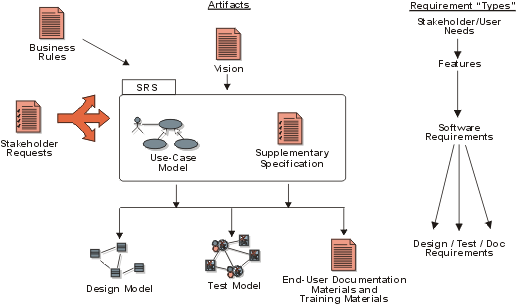Concepts: Traceability
More Information:
- Concepts: Requirements
- Concepts: Requirement Management
- Concepts: Types of Requirements
- Guidelines: Going from Business Models to Systems
- White Paper: Applying Requirements Management with Use Cases
- White Paper: Traceability Strategies for Managing Requirements with Use Cases
The purpose of establishing traceability is to help:
- Understand the source of requirements
- Manage the scope of the project
- Manage changes to requirements
- Assess the project impact of a change in a requirement
- Assess the impact of a failure of a test on requirements (i.e. if test fails the requirement may not be satisfied)
- Verify that all requirements of the system are fulfilled by the implementation.
- Verify that the application does only what it was intended to do.

The traceability hierarchy.
Traceability helps you understand and manage how input to the requirements, such as business rules and stakeholder requests, are translated into a set of key stakeholder/user needs and system features, as specified in the Vision document. The use-case model, in turn, outlines the how these features are translated to the functionality of the system. The details of how the system interacts with the outside world are captured in use cases, with other important requirements (such as non-functional requirements, design constraints, etc.) in the Supplementary Specifications. Traceability allows you to also follow how these detailed specifications are translated into a design, how it is tested, and how it is documented for the user. For a large system, use cases and Supplementary Specifications may be packaged together to define a Software Requirements Specification (SRS) for a particular "feature" or other subsystem grouping.
A key concept in helping to manage changes in requirements is that of a "suspect" traceability link. When a requirement (or other traceability item) changes at either end of a traceability link, all links associated with that requirement are marked as "suspect". This flags the responsible worker to review the change and determine if the associated items will need to change also. This concept also helps in analyzing the impact of potential changes.
Traceabilities may be set up to help answer the following sample set of queries:
- Show me user needs that are not linked to product features.
- Show me the status of tests on all use cases in iteration #n.
- Show me all supplementary requirements linked to tests whose status is untested.
- Show me the results of all tests that failed, in order of criticality.
- Show me the features scheduled for this release, which user needs they satisfy, and their status.
Example:
For a Recycling Machine system, the Vision document specifies the following feature:
-
FEAT10:The recycling machine will allow the addition of new bottle types.
This feature is traced to a use case "Add New Bottle Type":
-
The use case Add New Bottle Type allows the Operator to teach the Recycling Machine to recognize new kinds of bottles.
This traceability helps us verify that all features have been
accounted for in use cases and supplementary specifications.